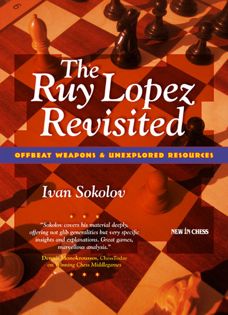Ruy Lopez Revisited, The
Ivan Sokolov

Expectations for opening books have risen steadily these past ten years, as they should. Tools like MegaBase (and other databases), ChessBase for managing and massaging the information, and super strong computer programs like the latest versions of Rybka and Fritz make an authors job much easier. Instead of slaving away gathering information and trying to organize it, he or she can spend their time deciding what is important, where theory stands and where it is going. These questions need to be answered for the book to be significant in an age when chess players armed with ChessBase, Rybka and a large database are happy being do-it-yourselfers who make their own personal opening tools.
Ivan Sokolovs second book for New in Chess, The Ruy Lopez Revisited is a good example of an opening book that offers the reader good value. Sokolov, a strong GM at one time among the elite, is well suited to the task of writing about the Ruy Lopez as he has played 1…e5 in answer to 1.e4 the past two decades, defending the Spanish Torture in myriad ways. The present work reflects his experiences and experiments with different variations in respectable Ruy Lopez lines outside 3…a6 except 3…Nf6 (the subject of entire books) and 3…d6 the ideas of which are perhaps best realized via the move-order 3…a6 4.Ba4 d6.
This works out as follows:
Content:
5 Introduction
9 Part I – Jaenisch Gambit
10
Chapter 1: Main Line with 7…Qd5
27
Chapter 2: Main Line with 7…Qg5
65
Chapter 3: Fully Playable – 5…Nf6
74
Chapter 4: The Risky 5…Be7
79
Chapter 5: The Main Deviation 4.Nc3 Nf6
109
Chapter 6: The Practical 4.d3
125 Part II – Delayed Jaenisch Gambit
126
Chapter 7: A Provocative Choice: 3…a6 4.Ba4 f5
139 Part III – Cozio Variation 140
Chapter 8: An Occasional Weapon: 3…Nge7
165 Part IV – Smyslov Variation 166
Chapter 9: The Sound 3…g6
177 Part V – Bird’s Defence
178
Chapter 10: Development – 6.d3
192
Chapter 11: The Accurate 6.Bc4 203 Part VI – Classical Variation
204
Chapter 12: 4.c3 – The Interesting 4…f5
212
Chapter 13: 4.c3 – The Uncommon 4…Nf6
219
Chapter 14: 4.0-0 – The Puzzling 4…Nge7
229
Chapter 15: 4.0-0 – The Viable 4…d6
235
Chapter 16: 4.0-0 Nf6 5.Nxe5 Nxe5 6.d4 – The Inferior 6…c6
241
Chapter 17: 4.0-0 Nf6 5.Nxe5 Nxe5 6.d4 – The Improvement 6…a6
247
Chapter 18: 4.0-0 Nf6 – Main Line 5.Nxe5 Nxe4
251
Chapter 19: 4.0-0 Nf6 – The Complex 5.c3
263
Index of Variations
267
Index of Players
While a certain school of thought advocates playing main line openings from the start of ones career forward, one cant help but think that Sokolov is on the right path when he proposes playing sidelines in the Ruy Lopez. One can only imagine the years spent by a club player (or anyone up to 2300 for that matter) waiting for the opportunity to play the Marshall Gambit. White has numerous ways to deviate from the main lines.
The variations that Sokolov examines range from the sharp (3…f5 the Jaenisch or Schliemann Gambit) to the solid (Smyslovs 3…g6), to the strategically challenging (Birds 3…Nd4) to the onetime Fischer/Spassky favorite (3…Bc5/3…Nf6 followed by 4…Nf6/4…Bc5). Sokolov normally answers the Ruy Lopez with 3…a6 but he has plenty of experience with all the lines he covers, except it would appear the odd-man out in this volume the one 3…a6 line covered the Schliemann/ Jaenisch deferred (3…a6 4.Ba4 f5). The author doesnt show a lot of confidence in this line but it should be mentioned that no less a player than the great Viktor Kortchnoi has toyed around with it, most visibly in his 1974 match with Anatoly Karpov.
Sokolov does a nice job of explaining what both sides are trying to do and where the problems lie for Black and offers suggestions on how to patch things up. He is objective in his assessments and practical in his advice pointing out which variations are likely to be reliable and which are best used as one game openings.
This reviewer has read similar advice by both Vlastimil Hort and Alex Yermolinsky to the effect that non-professionals who want to broaden their repertoire are best served by learning new variations within their traditional favorite opening instead of trying to learn a completely new system. That is a French Winawer player might take up the Classical French rather than the Alekhine. The idea is that the player gets the variety of a new variation with new middlegames but doesnt have to learn everything from scratch as all the alternatives to Whites 3.Nc3 are already known to him. This is definitely more manageable than learning another opening from scratch. Sokolovs offerings could be very easily be incorporated into such an approach offering variety and freshness while making opponents preparation much more difficult.
The Ruy Lopez Revisited can be recommended for players from 1800 on up.
